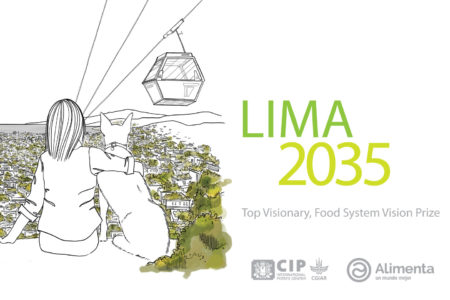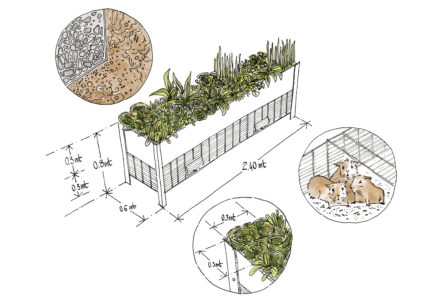Supported by $200,000 prize from the Rockefeller Foundation, Lima 2035 will promote food and water security in its desert slums in the lead-up to the city’s half-millennium.
Lima, Peru, Thursday, 7 January 2021 – An initiative to transform the Peruvian capital’s food system ahead of its 500th anniversary has won a $200,000 prize after being selected as a “Top Visionary” by the Rockefeller Foundation.
Already the driest megacity on Earth, Lima’s food and water supplies have been further aggravated by an influx of rural migration since the second half of the 20th century. These informal settlements now house four million residents – around 40 per cent of the population – over half of whom lack access to water.
 A typical household in these informal settlements spends up to 70 per cent of their monthly income on food and water. Not surprisingly, nutrition-related diseases are common: 35 per cent of children are anemic and 66 per cent of adults are overweight or obese.
A typical household in these informal settlements spends up to 70 per cent of their monthly income on food and water. Not surprisingly, nutrition-related diseases are common: 35 per cent of children are anemic and 66 per cent of adults are overweight or obese.
Lima 2035, a public-private-people partnership (4P), offers a renewed and reinvigorated vision to reverse these trends, inspired by the city’s agricultural and culinary heritage. Early conquistadors, who established Lima as the new capital in 1535, described the city as an ancient marvel: a stretch of the Atacama Desert transformed into a verdant valley.
“The vision of Lima 2035 is to reconnect with the city’s unique history, geography and culture to create a 21st-century food oasis,” said Barbara Wells, Director General of the International Potato Center (CIP), a CGIAR center dedicated to transforming food systems around the world, which is leading the initiative together with Grupo Alimenta.
“Through new policies, technologies and behaviors, Lima’s fragile desert environment can flourish for all its inhabitants.”
Soroush Parsa, the vision’s leader and Lead Innovation Scientist at CIP, added: “Lima 2035 offers a holistic plan, based on social justice, for bridging the inequality gap in food and water access, for securing the city in the face of climate change, and for generating more sustainable livelihoods and healthier lifestyles.”
The centerpiece of the plan will be a demonstration site in a desert slum in southeastern Lima, whose 218 families struggle every day to meet basic food and water needs. Latin American architects and urban designers will be invited to construct a community model that integrates three key innovations to reverse desertification through inspiring human-centered design.

The first innovation will harvest water from the dense fog that drifts above the city and creates small oases known as lomas. Water farms will be created using fog harvesting towers located in lomas around the city, reclaiming up to 3.6 million liters of fresh water a year for communities without access to piped or clean water. In a city that receives only a quarter inch of rain annually, these water farms could become the city’s second most important water source after the Rimac River.
The second innovation is the transformation of many of Lima’s nearly 400 abandoned pre-Columbian temples – called Huacas – into community spaces where food education and culture meet in a productive dialogue to reinvigorate Peru’s ancient agricultural and culinary traditions. Inspired by urban designer and member of Lima 2035, Jean Pierre Crousse, these food hubs will function as a 21st century commons, offering an open and inclusive space for exchanging ideas about food, nutrition, and urban and peri-urban farming.
The final innovation, made possible by the creation of food hubs and access to clean water, is a compact and efficient roof-top farming unit that unifies the cultivation of plants, animals, and living soil in a circular, regenerative nutrient loop. With this low-input, high-output system, a family’s home becomes their farm and they benefit from more vegetables in their diets while selling the surplus for additional income.
“Food is to Peruvians what soccer is to Brazilians,” said Vasco Masías, President of Grupo Alimenta, which is in a joint venture with CIP to launch the initiative. “Where Lima now stands was once the site of an indigenous civilization who had transformed the desert through irrigation. Lima is poised to rise again to the glory of its pre-Hispanic past by providing everyone access to clean running water and sufficient, healthy food.”
Other features of the Lima 2035 Vision include a range of long-term interventions to restore the city’s green past:
- Progressive water pricing to discourage wasteful use and generate municipal revenue to bring running water to Lima’s most marginal settlements
- Wastewater reclamation to replace the one billion liters of potable water currently used per month to keep Lima’s parks green
- The promotion of Andean guinea pig farming and anchovy consumption to improve protein intake at low cost
- The establishment of a new municipal park with a 10-km aerial cable car connected to the metro system, slashing commute times for tens of thousands of people.
- A revival in the consumption of, and creation of markets for, Peru’s highly nutritious “lost foods” or “orphan crops”, such as yacon, that can also fetch premium prices in foreign markets.
Taken together, these far-reaching interventions will offer a model of system transformation that blends the best of cultural knowledge with modern innovation to promote inclusive food citizenship based on improved water access.
According to Dr Wells, the initiative is an example of the CIP and Grupo Alimenta teams looking at challenges and opportunities with creativity, and is completely aligned with the new CGIAR research strategy, of which CIP is a founding member.
“We work with local and international partners to develop and scale science-based solutions to build climate-resilient, healthy and sustainable food systems. This is the essence of Lima 2035. We are thrilled by this recognition from the Rockefeller Foundation,” Dr Wells added.
The 10 “Top Visionaries” of the Rockefeller Foundation competition were selected from a pool of more than 1,300 applicants from 110 countries. Lima 2035 is the only South American winner with other finalists from Canada, China, India, Kenya, the Netherlands, Nigeria, and the United States.
For all media enquiries, please contact:
Donna Bowater
Marchmont Communications
+44 7929 212 534
donna@marchmontcomms.com
About Lima 2035
Lima 2035 is a public-private-people partnership led by CIP, a CGIAR research center, in collaboration with AgTech holding company Grupo Alimenta and a rapidly growing number of citizens. Their team aims to disrupt food deserts globally, starting with the world’s driest megacity on Earth – Lima, Peru. By 2035, they seek to help this ancient empire reclaim its glorious past by reversing current desertification trends to create a re-generative oasis for sustainable and compassionate food systems that promote healthy diets and improved incomes.
About the International Potato Center (CIP)
CIP is a CGIAR research center with a focus on potato, sweetpotato and Andean roots and tubers. It delivers innovative science-based solutions to enhance access to affordable nutritious food, foster inclusive sustainable business and employment growth, and drive the climate resilience of root and tuber agri-food systems. Headquartered in Lima, Peru, CIP has a research presence in more than 20 countries in Africa, Asia and Latin America. www.cipotato.org
CGIAR is a global research partnership for a food-secure future. Its science is carried out by 15 research centers in close collaboration with hundreds of partners across the globe. www.cgiar.org
About Grupo Alimenta
Alimenta is a Peruvian ecosystem of connected companies, with more than 20 years of experience. We believe that it is possible to feed the world in a sustainable way, in harmony with nature, and therefore we constantly work to achieve it, focusing on businesses that positively impact the food chain: from regenerative fertilization to high nutrition food products.
Alimenta combines the knowledge of nature with science. Inspired by the way natural ecosystems work, ours generates synergies that achieve positive impact, disruptive and innovative changes on a large scale. www.alimenta.pe
Food System Vision Prize
The Rockefeller Foundation’s Food System Vision Prize is an invitation for organizations across the globe to develop a Vision of the regenerative and nourishing food system that they aspire to create by the year 2050. Rockefeller partnered with SecondMuse and OpenIDEO to amplify the discourse on the state and the future of the world’s many food systems. And to empower communities globally to develop actionable solutions and become protagonists in their own food future.
